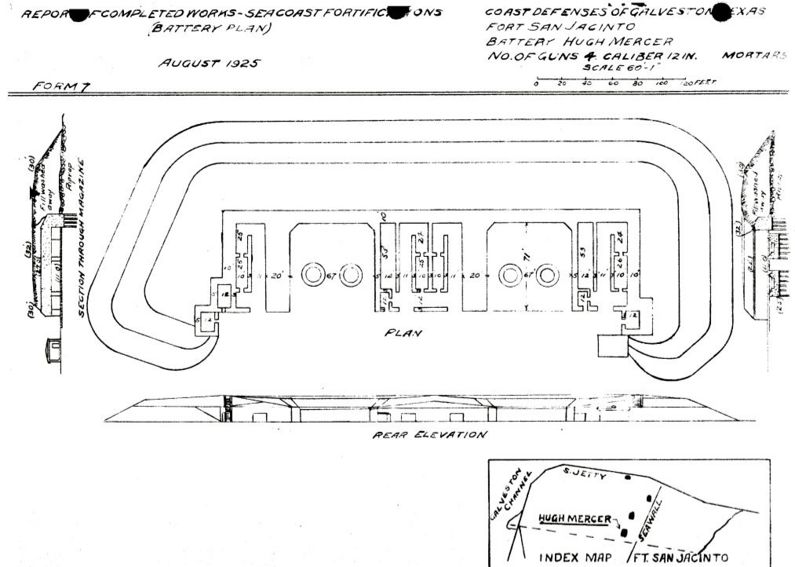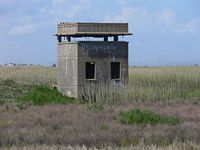Battery Mercer
|
Battery Mercer (1899-1943) - Battery Hugh Mercer was a reinforced concrete, Endicott Period 12 inch coastal mortar battery on Fort San Jacinto, Galveston County, Texas. The battery was named in G.O. 194, 27 Dec 1904, after Brigadier General Hugh Mercer, Continental Army, who died 12 Jan 1777, of wounds received in action at the Battle of Princeton, New Jersey 3 Jan 1777. Battery construction started 20 Feb 1897, was completed in the summer of 1899 and transferred to the Coast Artillery for use 25 Oct 1899 at a cost of $ 117,700.00. The Battery was destroyed by the 1900 Galveston hurricane and was rebuilt between 1901 and 1907 and was accepted for service 21 Aug 1911 at a cost of $ 293,522.75. Deactivated in 1943. Endicott Period (1890-1910)Part of the Harbor Defense of Galveston. Originally built as an Endicott Period concrete coastal mortar battery with eight 12" M1890MI mortars mounted on M1896MI carriages. The mortars were configured into two mortar pits of four mortars each. At the time of the Galveston hurricane the battery was complete and accepted for service. The hurricane destroyed the battery beyond repair and the mortars and carriages were scattered about and buried in sand. They were recovered, cleaned up and placed in storage. The battery was rebuilt and the sand ramparts restored between 1901 and 1906 and the mortars remounted. Fort San Jacinto was not re-garrisoned until 1911 when instability in Mexico made Fort Crockett a major staging area. The battery was not accepted for service until 21 Aug 1911.
World War I (1917-1918)The U.S. entry into World War I resulted in a widespread removal of large caliber coastal defense gun tubes for service in Europe. Many of the gun and mortar tubes removed were sent to arsenals for modification and mounting on mobile carriages, both wheeled and railroad. Most of the removed gun tubes never made it to Europe and were either remounted or remained at the arsenals until needed elsewhere. In May of 1918 Fort Crockett was first directed to dismount and prepare for shipment four of the Battery Izard 12" mortars. That directive was modified on 25 May 1918 to dismount and prepare for shipment all eight of the 12" mortars and that four of the mortars would be replaced with four mortars from Battery Mercer at Fort San Jacinto when transport was available. The reduction of mortar battery pits from four mortars to two mortars was part of a large program that affected most coastal mortar batteries. The reduction reduced crowding in the pits and improved firing rates so that no loss of capability was experience but the number of people required in each pit was cut in half. The four mortars from Battery Mercer on Fort San Jacinto were transferred to Battery Izard 10 Apr 1922 so Battery Izard was unarmed from 1918 to 1922. The carriages for the four mortars to be transferred were salvaged 26 May 1920.

World War II (1941-1945) By the start of World War II the mortar batteries were obsolete and the first large scrap drive in late 1942 provided an opportunity to deactivate the mortar batteries and scrap the massive mortars and their carriages 24 Jan 1943. The central portion of Battery Mercer containing the shell and powder rooms was converted into a combined HECP-HDCP complex housing all of the personell and equipment needed to provide control over ships entering and leaving the harbor. A two story observation tower was built on the top of the complex for the Harbor HDCP function. The complex below contained quarters for the duty officers and enlisted personnel, communications and coding equipment, chart rooms and offices. This complex was formally accepted for service 18 Jul 1944 at a cost of $ 53,696.48, but it was in use before that date.
Current StatusNo period guns or mounts in place.
Sources:
Links: Visited: 12 Nov 2009
| ||||||||||||||||||||||||||||||||||||||||||||||||||||||||||||||||||||||||||||||||||||||||||||||||||||||